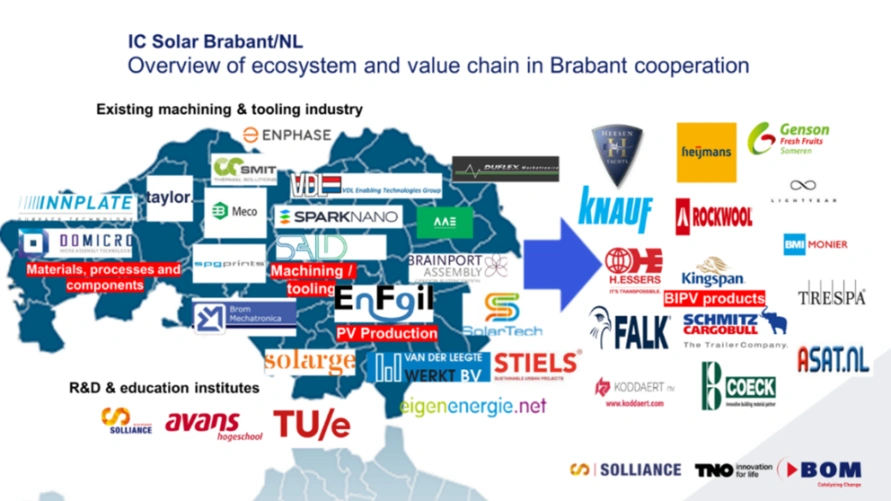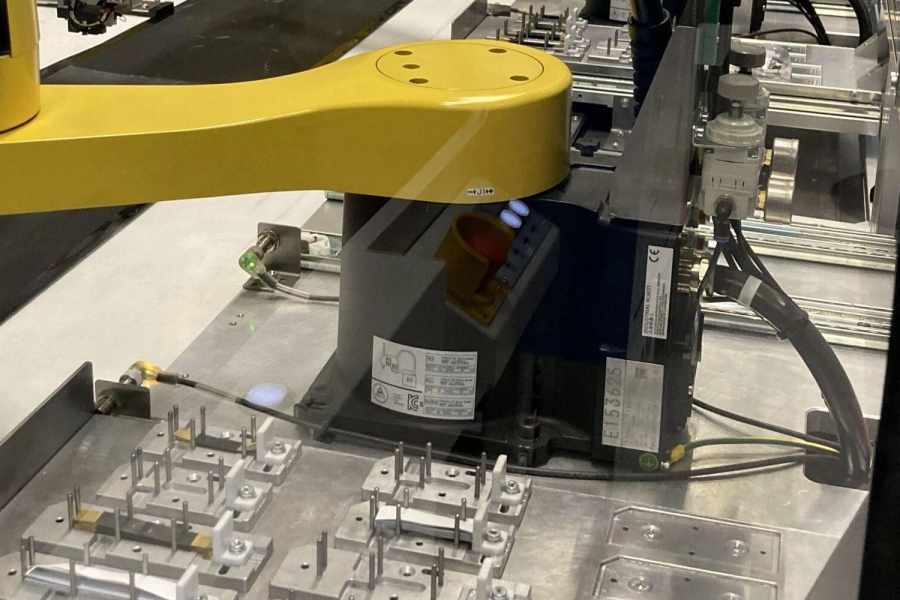Until about ten years ago, the Netherlands was a leader in solar technology, the technique to create electricity from sunlight. In Brabant, a great deal of investment was made to develop knowledge. Then China quickly caught up and set up a successful solar energy production industry. The leading position that the Netherlands, thanks to Brabant, once held was lost to China. With the Innovation Coalition Solar, Brabant is rejoining the race. The signing of the agreement between the province of North Brabant, Brabant Development Agency (BOM), and TNO, a partner in Solliance, marked a new phase in the application of solar energy.
Martijn van Gruijthuijsen (Deputy for Economy, Talent Development, and Finance Province of North Brabant): “In Brabant, we are working on solutions for today's and tomorrow's social challenges. Here you will find the knowledge to solve a problem and the smart manufacturing industry to realize that solution. With this new collaboration, we hope to make solar energy better, cheaper, and more available, and we lay the foundation for more production in Europe.”
Paul Gosselink, Program Manager New Energy BOM, about Innovation Coalition Solar: “Brabant has a tremendous amount of knowledge, we deserve a place on the world stage. With a promising technology — which may become of great importance for the energy transition — we bring the solar manufacturing industry back to Brabant. And thus back to Europe. The innovation coalition focuses on the entire chain. From the development of knowledge, new materials, and concepts to the translation into business activity, production technology, and applications.”

Learn more

In the laboratory of the European knowledge center and research consortium TNO/Solliance at the High Tech Campus in Eindhoven, research institutes and universities (TNO including former ECN, Eindhoven University of Technology, Holst Centre, Imec and Forschungszentrum Jülich) collaborate with industry for the development of thin-film PhotoVoltaics (PV): laminates based on perovskite solar cells, which effectively convert sunlight into energy. BOM has played an important role in the creation of Solliance and the Innovation Coalition Solar and is still closely involved with both.
The advantages of perovskite for solar energy production
All over the world, rooftops are covered with the well-known solar panels. These are mostly made of silicon. This technology has matured and offers significant advantages compared to fossil energy sources. There are also areas for improvement with this technology. Silicon solar panels are not exactly flexible, and not always aesthetically pleasing. It also takes a lot of energy to produce them and they are not very circular. Moreover, the potential of the sun as a sustainable energy source goes far beyond what we currently utilize. By integrating design freedom with the construction, infrastructure, and automotive industries with the PV industry, you create new opportunities, as we know in Brabant. Perovskite solar films have numerous advantages:
- The raw materials to make perovskite are not scarce, but are inexpensive and found in many parts of the world.
- Only a very thin layer of perovskite (between 0.5 and 1 micrometer) is needed in a solar cell. This means even lower material costs.
- The perovskite solar cells are processed into a flexible film, for example, on the hood, roof, and windows of your electric car. Or on the facade panels of buildings, on sound barriers, or in the road surface. This significantly increases the surface area with which you can generate solar energy.
- By producing and supplying rolls of perovskite film on customer demand (e.g., from facade or roof manufacturers) in the desired length and width, you better connect both markets and increase mutual profitability. We call this Mass Customization of PV or Mass Customized PV.
- Perovskite can be applied with a relatively simple deposition process (applying the layers on a specific surface, the substrate). This requires relatively less expensive machines and production processes.
- The layers of perovskite can be deposited at lower temperatures. This also keeps production costs low. More importantly, it reduces CO2 emissions during production.
- Relatively little energy is needed to make a perovskite cell. This allows the solar cell to quickly pay back the energy needed to make the cell.
- The application of perovskite is relatively easy to make circular, where the material can be almost entirely reused to produce new perovskite solar cells ('upcycling').
- The efficiency of standard solar cells can be further increased with perovskite technology by using tandem technology. For the same output, you then need fewer solar panels, and thus - for example - fewer meadows are needed as solar parks.
- By combining perovskite with silicon cells, for example - in a so-called tandem application - a solar cell with very high efficiency is created, up to 35% in the long run.
Complete chain in Brabant to serve all of Europe
The intention is ultimately to establish a complete chain in Brabant for the production of flexible Roll-to-Roll (R2R) produced perovskite solar film, which can serve the European market at an economically attractive price. The geopolitical situation also plays a role. The Netherlands aims to be independent from countries like Russia and China for energy supply and sustainable energy solutions. The intention is that the solar film will be produced in large quantities. The more produced, the lower the price.
Peter Toonssen, business developer at TNO: “To make the technology affordable, mass production is necessary. Investments are not getting off the ground now because there is no market yet. But there is no market because there are no products yet. To break this chicken-and-egg problem, more demonstration projects need to be developed.”
And that is precisely what BOM is striving for, according to Paul. “Among other things, by connecting Brabant companies to this project that can and want to engineer the technology into a feasible production process, and those that start producing cells or laminates, or selling machines for that production. This way, we jointly increase the number of application possibilities in PV and realize from Brabant an economic and ecological impact for the world; the ultimate goal of this Innovation Coalition Solar project.”
Scaling up production responsibly
However, by early 2024 there will only be one pilot production line, at the Brainport Industries Campus in Eindhoven. This is not yet based on perovskite, but on CIGS (another type of flexible solar cell). This line is also used for research purposes. In the research line, essentially a programmable collection of robots surrounding a foil transport and lamination platform, processes are developed for making flexible semi-finished products with PV functionality in all conceivable sizes, shapes, and electrical capacities. These can also be produced on the same line. Component manufacturers can integrate such semi-finished products into their own products without significantly altering their production process. Existing companies can thus embark on new paths, and it offers opportunities for newcomers to the market.
Paul: “We work with entrepreneurs on three tracks:
- the development of a ‘New Company’ that will produce flexible solar cells and perovskite laminate.
- finding entrepreneurs who can jointly supply production equipment to the new company (and others).
- developing applications in the built environment and infrastructure, including the necessary tools to demonstrate that these new PV applications truly work and are of good quality.”
BOM builds clusters and assists entrepreneurs (and attracts them to Brabant if we currently lack them here) who want to work with this new technology and see business potential in it, in developing, investing, and internationalizing. Paul: “We also ensure that the ‘New Company’ gets a business plan with one or more entrepreneurs, and we actively think along with the financing, where BOM’s various funds may also play a role. This way, we strengthen the entire ecosystem.”
Peter: “BOM is an accelerator and acquisition instrument, with which we visit many companies in collaboration with TNO. On one hand, these are companies waiting for products from this line. On the other hand, there are parties aiming to establish such production lines in multiple factories. There are still countless opportunities for market parties. In this region, machine builders like VDL ETG, IBE, Brom Mechatronica, and AAE are already active in this field. This distinguishes Brabant from other regions. It would be great if we could establish a factory on our own soil – in the province of North Brabant – to produce perovskite cells and then integrate them into all possible laminates through mass customization.”
SolarNL for the development of Dutch solar energy manufacturing industry
The energy transition must be faster and more efficient if the Netherlands aims to meet the climate targets and be climate neutral by 2050. The new Dutch program SolarNL, which started in February 2024, contributes to this. SolarNL focuses on three innovative solar technologies, each of which will be competitive in different markets:
- high-efficiency silicon 'heterojunction' solar cells
- flexible solar films based on the new material perovskite
- custom-made and lightweight solar panels for integration into buildings and automotive applications, and 'tandem solar cells' with very high efficiency.
SolarNL is implemented by a consortium of nine Dutch solar technology companies. Supported by a grant from the National Growth Fund, InvestNL, and private investors, production facilities are being built at multiple locations in the Netherlands with the aim of achieving a production volume of over 7 GWp/year of innovative solar cells and solar panels. Additionally, TNO is conducting a development and innovation program and seven academic partners, led by research institute AMOLF, are carrying out a fundamental research program for future breakthrough innovations. Finally, four universities of applied sciences are developing a Human Capital program to fill the 2,000 new jobs created by SolarNL.
BOM contributed to the Innovation Coalition Solar case
Developing
- Investor Readiness Program, Market Access Program
- Bringing together companies with TNO
- Developing projects together with TNO. Once a project is finalized, TNO executes the content. BOM periodically checks in the project team on achieving results in a timely manner and everyone’s commitment
Investing
- Financing where needed; business financing (BOM ventures) and/or project financing (Energiefonds Brabant)
Internationalising
- Acquiring companies and providing assistance with market, permits, network, promotion, and branding support when needed
- International trade: account support, promotion
